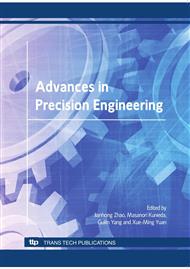p.178
p.183
p.188
p.193
p.198
p.203
p.208
p.213
p.218
Effect of Tool Cone Angle on Micro Machining Based on the EMR Effect
Abstract:
Aiming at micro machining of 3D microstructure of brittle materials with a novel tiny-grinding wheel based on the electro-magneto-rheological (EMR) effect, five conical tools with different cone angles are designed to reveal the effect of the cone angle on the machining characteristics. The distribution of the magnetic and electric fields in the polishing area is simulated using the finite element analysis software, and the machining experiments of micro groove were conducted to confirm the simulation results. Experimental results indicate that the material removal rate increases first and decreases afterwards with the increase of the cone angle, and the section width of micro groove increases but the section depth of micro groove shows a fluctuation phenomenon within a certain range. The intensities of the electric and magnetic fields on the tip of the conical tool with the 45° cone angle are at a larger level in the five tools, which is helpful to form a stable tiny-grinding wheel based on the EMR effect and obtain a better machining effect, so the tool with the 45° cone angle is an effective and ideal machining tool for the machining of 3D microstructure.
Info:
Periodical:
Pages:
198-202
Citation:
Online since:
September 2010
Authors:
Price:
Сopyright:
© 2010 Trans Tech Publications Ltd. All Rights Reserved
Share:
Citation:


